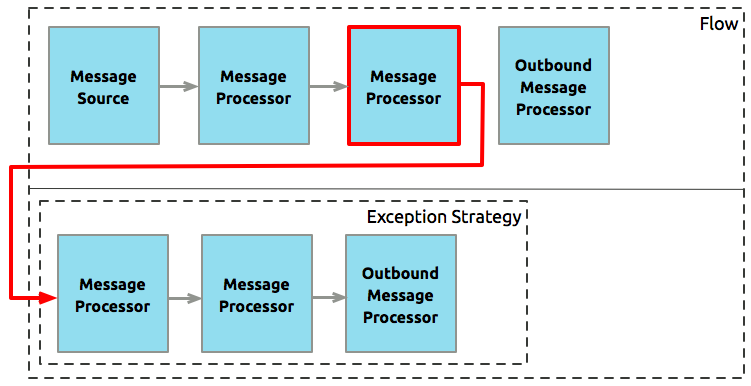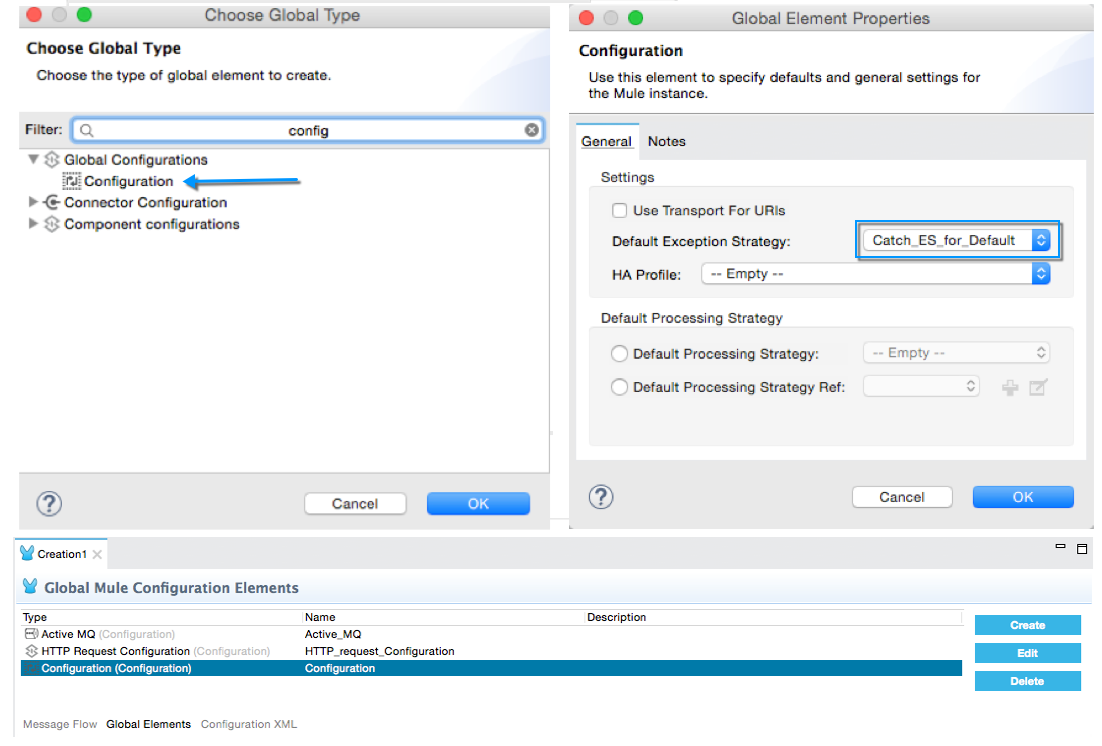
Error Handling
Mule provides numerous options for handling errors. Faults that occur within Mule are referred to as exceptions; when an activity in your Mule instance fails, Mule throws an exception. To manage these exceptions, Mule allows you to configure exception strategies.
Mule’s default exception strategy — which implicitly applies to all Mule applications — manages errors (that is. thrown exceptions) in Mule flows. When your flows require more sophisticated error management, you can implement one or more exception strategies to construct precise, efficient protocols for handling errors.
From a high level perspective, errors that occur in Mule fall into one of two categories: System Exceptions, and Messaging Exceptions.
System Exceptions
Mule invokes a System Exception Strategy when an exception is thrown at the system-level (that is, when no message is involved, exceptions are handled by system exception strategies). For example, system exception strategies handle exceptions that occur:
-
During application start-up
-
When a connection to an external system fails
When a system exception strategy occurs, Mule sends an exception notification to registered listeners, logs the exception, and — if the exception was caused by a connection failure — executes the reconnection strategy. System Exception Strategies are not configurable in Mule.
For programmatic exception information, see the MessagingException object.
Example Scenario
Mule establishes a connection to a JMS broker in order to receive a message. When Mule attempts to use the connection to consume a message the connection fails, which causes Mule to invoke the system exception strategy. Because the failure occurred before any message was received for processing, Mule invoked the system, rather than messaging, exception strategy.
Messaging Exceptions
Mule invokes a Messaging Exception Strategy whenever an exception is thrown within a flow (i.e., whenever a message is involved, exceptions are handled by messaging exception strategies).
When a message being processed through a Mule flow throws an exception, normal flow execution stops and processes transfers to the message processor sequence within the exception strategy. You can incorporate any number of message processors – and in one case, other exception strategies – into an exception strategy to handle the exception precisely as you wish. The diagram below illustrates what happens when a message throws an exception.

Mule supports five types of messaging exception strategies, each of which is capable of handling errors that occur in flows which process transactions:
| Exception Strategy | Use | Transaction Error Handling |
|---|---|---|
Defined and implicitly applied by default to handle all messaging exceptions that are thrown in Mule applications |
When a message throws an exception, the default exception strategy rolls back the message and logs the exception. |
|
Define a catch exception strategy to customize the way Mule handles any exception. Catch exception strategies consume inbound messages. |
When a message throws an exception, the catch exception strategy always commits the transaction and consumes the message. |
|
Define a rollback exception strategy to ensure that a message that throws an exception in a flow is rolled back for reprocessing (if the message source supports redelivery). Rollback exception strategies do not consume inbound messages. |
When a message throws an exception, the rollback exception strategy makes one or more attempts to rollback the message and redeliver it for processing (if the message source supports redelivery). If the message exceeds its redelivery attempts, then the rollback exception strategy takes the message from its inbound source and consumes the message. |
|
Define a reference exception strategy to refer and adhere to the error handling parameters defined in a global catch, rollback or choice exception strategy. |
When a message throws an exception, the reference exception strategy refers and adheres to the error handling parameters defined in a global catch, rollback or choice exception strategy. (The reference exception strategy itself never actually performs any rollback, commit, or consume activities.) |
|
Define a choice exception strategy to customize the way Mule handles a message that throws an exception based on the message’s content at the moment it throws the exception. |
When a message throws an exception, the choice exception strategy makes a decision about where to route the message for further processing. (The choice exception strategy itself never actually performs any rollback, commit, or consume activities.) |
Characteristics of Messaging Exception Strategies
-
Each flow can contain only one exception strategy. However this can be a choice exception strategy that then refers to other nested exception strategies.
-
Choice exception strategies can contain one or more catch and/or rollback exception strategies. (Rollback and catch exception strategies cannot, however, contain other exception strategies.)
-
Each exception strategy can contain any number of message processors.
-
The exception strategy message processors should not throw exceptions, because you cannot create a nested exception strategy for these message processors.
Default Exception Strategy
Mule’s default exception strategy implicitly and globally handles all messaging exceptions that are thrown in Mule applications. You can override Mule’s default exception strategy by adding a catch, rollback, or choice exception strategy to a flow. Otherwise, when an exception is thrown in a flow, Mule automatically rolls back any pending transaction and logs the exception; if no transaction is involved, the default exception strategy simply logs the exception.
When to Use
Allow Mule’s default exception strategy to activate whenever you don’t require a customized strategy for handling errors.
Configuring a Default Exception Strategy
Because the default exception strategy is implicitly applied to all Mule flows, you don’t need to specify it explicitly. Mule’s default exception strategy automatically activates whenever an error occurs in any of your flows. The default exception strategy cannot be configured using the Studio interface. However, you can build a global default exception strategy to customize the way Mule implicitly handles errors in your application. Refer to the Custom Default Exception Strategies section below.
Custom Default Exception Strategies
You can create one or more global exception strategies to reuse in flows throughout your entire Mule application. First, create a global exception strategy, then add a reference exception strategy to a flow to apply the error handling behavior of your new global exception strategy.
Consult the individual catch, rollback or choice exception strategy pages for details on how to create them globally; consult the reference exception strategy page for details on how to reuse them globally.
Creating a Global Default Exception Strategy
Create a global default exception strategy to customize the way Mule implicitly handles all exceptions that occur in your application. To do so, you must first create a configuration file to contain the catch, rollback, or choice exception strategy for the global default exception strategy to reference. Then, add a Reference Exception Strategy to reference the other global exception strategy in the configuration file.
Studio Visual Editor
-
Decide which type of exception strategy to configure to best meet your default exception strategy requirements: catch, rollback or choice.
-
Follow the procedure detailed in one of the following documents to create a global catch, rollback, or choice exception strategy for your global default strategy to reference:
-
In Studio, create a simple Global Configuration element (below, left), configure it to reference the global exception strategy you created in step 2 (below, right), then click OK to save.

-
Mule implicitly invokes your customized global exception strategy each time an exception is thrown in a flow in the application.
Studio XML Editor or Standalone
-
Decide which type of exception strategy to configure to best meet your default exception strategy requirements: catch, rollback or choice.
-
Follow the procedure detailed in one of the following documents to create a global catch, rollback or choice exception strategy for your global default strategy to reference:
-
<catch-exception-strategy name="Catch_ES_for_Default"> <logger level="INFO" doc:name="Logger"/> </catch-exception-strategy> <http:listener-config name="HttpListenerConfiguration" host="localhost" port="8081" doc:name="HTTP Listener Configuration"/> <flow name="Creation1Flow1" doc:name="Creation1Flow1"> <http:listener config-ref="HttpListenerConfiguration" path="/" doc:name="HTTP"/> <cxf:jaxws-service doc:name="SOAP"> </cxf:jaxws-service> ... </flow>xmlView the Namespace
<mule xmlns:http="http://www.mulesoft.org/schema/mule/http" xmlns:cxf="http://www.mulesoft.org/schema/mule/cxf" xmlns="http://www.mulesoft.org/schema/mule/core" xmlns:doc="http://www.mulesoft.org/schema/mule/documentation" xmlns:spring="http://www.springframework.org/schema/beans" xmlns:xsi="http://www.w3.org/2001/XMLSchema-instance" xsi:schemaLocation="http://www.springframework.org/schema/beans http://www.springframework.org/schema/beans/spring-beans-current.xsd http://www.mulesoft.org/schema/mule/core http://www.mulesoft.org/schema/mule/core/current/mule.xsd http://www.mulesoft.org/schema/mule/http http://www.mulesoft.org/schema/mule/http/current/mule-http.xsd http://www.mulesoft.org/schema/mule/cxf http://www.mulesoft.org/schema/mule/cxf/current/mule-cxf.xsd">xml
-
Add another global element,
configuration, below the global exception strategy. -
To the configuration global element, add the attributes according to the table below. Refer to code sample below.
Attribute Value defaultExceptionStrategy-ref
name of your global exception strategy
doc:name
unique name for the element, if you wish (not required for Standalone)
doc:description
documentation for the element, if you wish
<catch-exception-strategy name="Catch_ES_for_Default" when="#[payload.null]"> <logger level="INFO" doc:name="Logger"/> </catch-exception-strategy> <configuration defaultExceptionStrategy-ref="Catch_ES_for_Default" doc:name="Configuration" doc:description="Use as implicit default exception strategy."/> <http:listener-config name="HttpListenerConfiguration" host="localhost" port="8081" doc:name="HTTP Listener Configuration"/> <flow name="Creation1Flow1" doc:name="Creation1Flow1"> <http:listener config-ref="HttpListenerConfiguration" path="/" doc:name="HTTP"/> <cxf:jaxws-service doc:name="SOAP"> </cxf:jaxws-service> ... </flow>xml
Other Ways of Handling Errors
Until Successful Scope
Until Successful behaves similarly to a rollback exception strategy. This scope attempts to route a message through its child flow until the message is processed successfully. However, you can define the maximum number of processing attempts the Until Successful scope undertakes before it reverts to handling the message as though it were an exception. You can configure a Failure Expression, an Ack Expression, or a Dead Letter Queue Reference to instruct the scope on how to manage messages that it cannot process. In this respect, Until Successful scope behavior is similar to a rollback exception strategy. Refer to the Scopes documentation for details.
Exception Filter
Mule’s Exception filter stops normal flow execution when it discovers a message that contains a message in the exceptionPayload field. By comparison, an exception strategy typically stops normal flow execution when a message throws an exception in the flow. You can combine the two and configure the exception filter to stop normal flow execution and throw an exception, which triggers the exception strategy. Refer to the Filters documentation for configuration details.
Reconnection Strategies
Mule’s Reconnection Strategies specify how a connector behaves when its connection fails. You can control how Mule attempts to reconnect by specifying a number of criteria: the type of exception, the number and frequency of reconnection attempts, the notifications generated, and more. With a reconnection strategy, you can better control the behavior of a failed connection by configuring it, for example, to reattempt the connection only once every 15 minutes, and to stop trying to reconnect after 10 attempts. Reconnection strategy behavior resembles that of exception strategies, but reconnection strategies provide instructions specifically for — and limited to — reconnection attempts. Refer to the Reconnection Strategies documentation for details.
CXF Error Handling
Web services that utilize CXF can implement Mule exception strategies (such as the Catch and Rollback exception strategies) that are compatible with CXF. Consult the CXF Error Handling documentation for details.
See Also
-
To understand how to configure Mule’s exception strategies to handle the most common error handling use cases, read Exception Strategy Most Common Use Cases.



